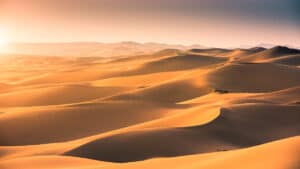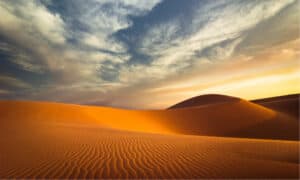Deserts are extremely dry and are one of the most extreme habitats on the planet. It is estimated around 33% of the earth’s land surface is desert, and these areas get no more than 10 inches of precipitation a year. While most think deserts are barren wastelands, you can find a variety of wildlife and plants adapted to live in these dry regions. Here you will discover the 9 largest animals that live in deserts and the massive sizes that some reach.
Animals in deserts are uniquely adapted to survive in the driest, hottest, and coldest temperatures. Animals in a desert can be as small as a mouse, but let’s take a look at 9 of the largest.
Desert Bighorn Sheep
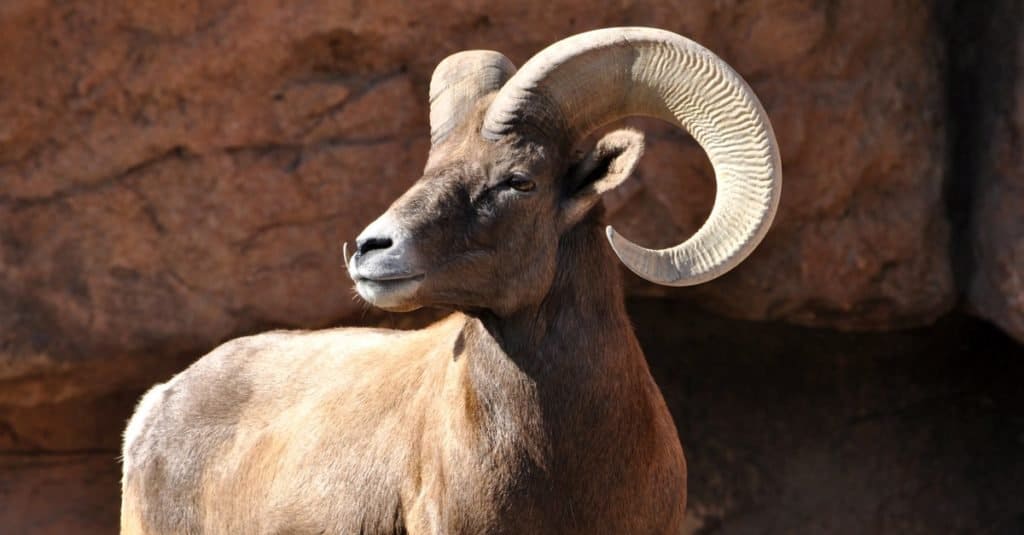
Bighorn sheep
can be found in the Mojave, Sonoran, Chihuahuan, and Great Basin deserts.
©Georgia Evans/Shutterstock.com
| Height | Length | Weight |
|---|---|---|
| 2.5 to 3.5 ft. | 4.1 to 6 ft. | 150 to 300 lbs |
Native to North America, the bighorn sheep is a species that lives in mountain rocky regions. Bighorn sheep can be found in the Mojave, Sonoran, Chihuahuan, and Great Basin deserts, which are the four major desert landscapes in North America.
The desert bighorn sheep (Ovis canadensis nelsoni) is a subspecies adapted to survive in the extreme heat and cold, with their body able to tolerate changes in temperature. They can also survive on little water and can retain water in their bodies through the food they eat. Bighorn sheep are able to lose 30% of water in their body and drinking water quickly helps them recover.
The size of bighorn sheep varies, but males are the largest, with the biggest of them getting near 300 lbs. Males have large curved horns that can weigh up to 30 lbs, while females have much smaller horns. Being a browser, this large desert animal feeds on plants like willow, sage, grasses, and cacti.
Bighorn rams are great climbers, and their hooves allow them to have great traction and balance. They are able to stand on ledges as small as two inches, which is useful in escaping predators like coyotes, wolves, and cougars.
Gobi Bear
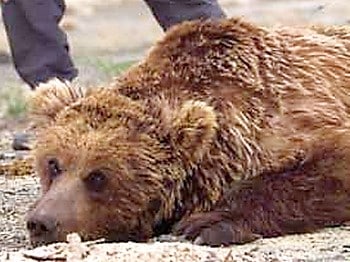
Gobi bears are the only type of
bear
species that is able to tolerate the extreme heat of hot deserts.
©Ursus arctos gobiensis / CC BY-SA 1.0 – License
| Height | Length | Weight |
|---|---|---|
| 3.6 to 4.6 ft. | 4.8 to 5.4 ft. | 211 to 304 lbs |
Gobi bears (Ursus arctos gobiensis) are the only type of bear species that is able to tolerate the extreme heat of hot deserts. Gobi bears are a subspecies of brown bears and are native to western Mongolia in the Gobi desert. Listed as critically endangered, the Gobi bear is one of the rarest bears on the planet. This bear is the only known bear that uses a desert habitat as its home, and an estimated 51 specimens are left in the wild.
Gobi bears are a smaller species of brown bears adapted to lie in mountainous and flat desert habitats. They are omnivorous, feeding on berries, wild onions, rodents, insects, and vegetation they find. Gobi bears mainly eat plants, and their diet is around 1% meat. Their body is able to store fat and water effectively.
The change of the Gobi desert’s climate and the destruction of the environment by mining are the main causes of the Gobi bears’ loss in population. As their habitat gets hotter, water and food become more scarce. No populations of the gobi bear currently exist in captivity, and only a few are left in the wild.
Common Ostrich
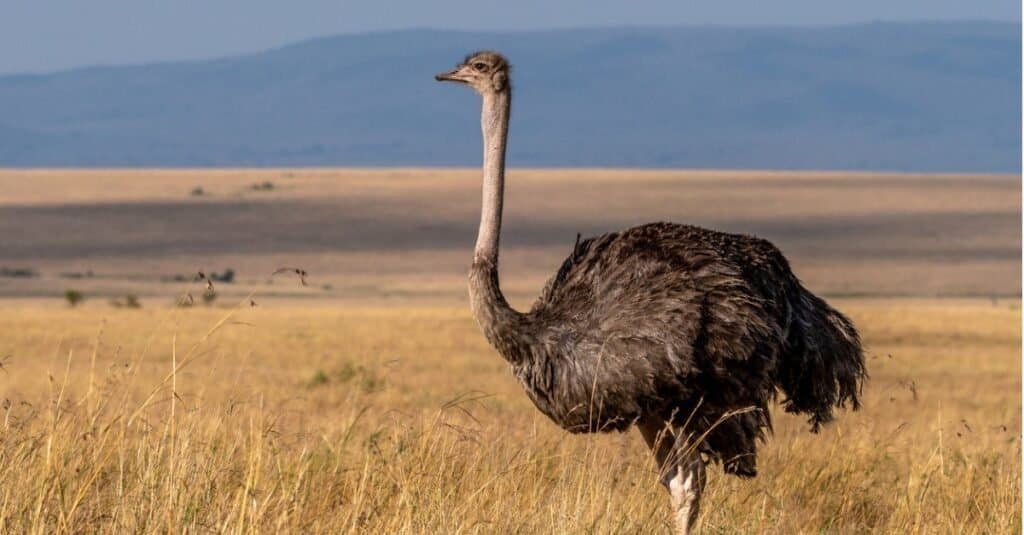
Common ostriches are native to
Africa
and live within the savanna and desert regions of the continent.
©NileshShah/Shutterstock.com
| Height | Wingspan | Weight |
|---|---|---|
| 5.6 to 9 ft | 4.9 to 6.6 ft. | 140 to 300 lbs |
The ostrich is the largest bird in the world and is flightless due to its size. Ostriches are bipedal, and this bird can run up to 43 mph. There are two species of ostrich in the world, the common ostrich (Struthio camelus), and the Somali ostrich (Struthio molybdophanes). The common ostrich is the larger of the two and is also found more often in desert habitats. Common ostriches are native to Africa and live within the savanna and desert regions of the continent.
Male ostriches are usually larger than females. The legs of these large birds are very powerful, and allow them to take strides that cover 10 to 16 feet in space. They only have two toes, which helps them get up to greater speeds. Ostriches have large wings but cannot fly and use them to balance themselves when moving at high speeds.
Ostriches are omnivores, but most of their diet is made up of plants. They feed on things like roots, seeds, leaves, and fruit. Lizards, insects, and snakes are some of the small animals they eat. While this large bird only feeds on small animals, they are very powerful and can kill larger animals. They have strong legs with sharp claws that can cause fatal damage and lacerations. This large bird lives together in flocks as small as 10 members and can get as large as 100.
Kalahari Lions
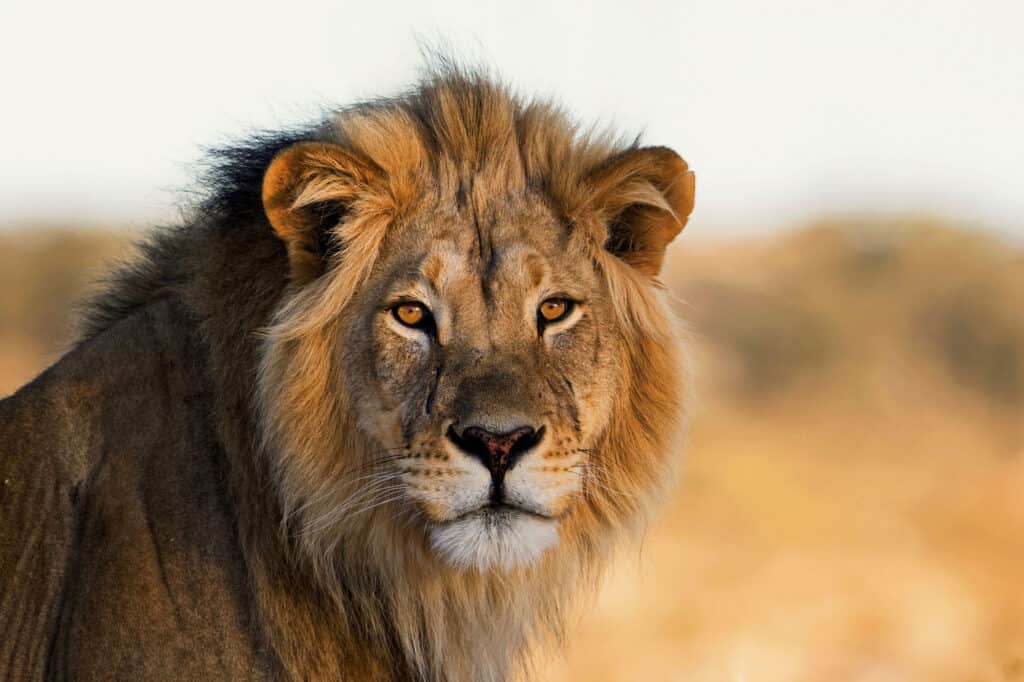
Native to Africa, lions live in savannas, grasslands, thick brush, open plains, and forest habitats.
©SeymsBrugger/Shutterstock.com
| Height | Length | Weight |
|---|---|---|
| 3.6 to 3.9 ft. | 5.2 to 6.8 ft. | 280 to 420 lbs |
Lions are some of the largest cats in the world and are very adaptable species. Native to Africa, lions live in savannas, grasslands, thick brush, open plains, and forest habitats. In Africa, you can find a variety of deserts like the Sahara, Namib, and the Kalahari desert, which are a few of the deserts that lions have roamed. While lions are not always found in deserts, they are some of the largest animals that live in them.
Lions are able to live in a variety of habitats, but they have deserts as some of the habitats they are adapted to. A lion’s coat is able to protect from the coldness of the desert night. Lions that live in deserts also have slightly longer legs, helping them traverse longer distances. Since there is a lack of water in deserts, lions are also able to go long periods without drinking water and are able to hydrate from the blood in their food.
Donkeys
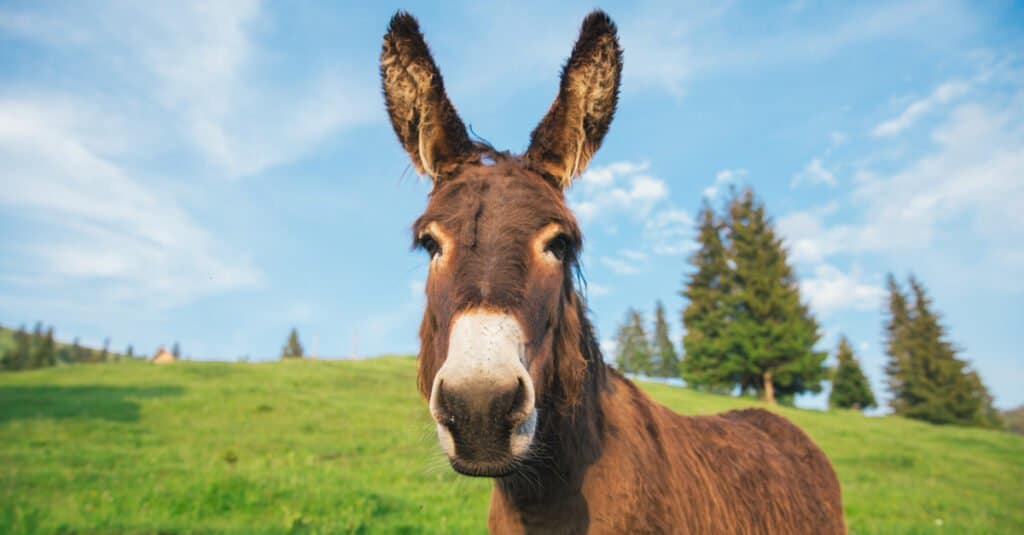
Donkeys are not only some of the largest animals in deserts, but they are also some of the most well adapted.
©Angyalosi Beata/Shutterstock.com
| Height | Length | Weight |
|---|---|---|
| 2.6 to 5.2 ft. | 3 to 4 ft. | 180 to 570 lbs |
Wild donkeys are a very hardy species and are able to survive in the extremely arid climate of the desert. Donkeys live in a variety of deserts across North America, but they are originally native to northern Africa. Donkeys are not only some of the largest animals in deserts, but they are also some of the most well adapted. They have large ears that help them dissipate heat, and their gray color coats help them reflect the blistering sun.
Donkeys are also able to go long periods without water and are able to lose 30% of the water in their body without severe consequences. It is estimated they can go around a week without water. Donkeys vary greatly in size, with the largest of them reaching up to 570 lbs. The strength of the donkey allows them to carry up to 125 lbs on their back, and their hardiness helps them haul items through the desert climate.
Camels
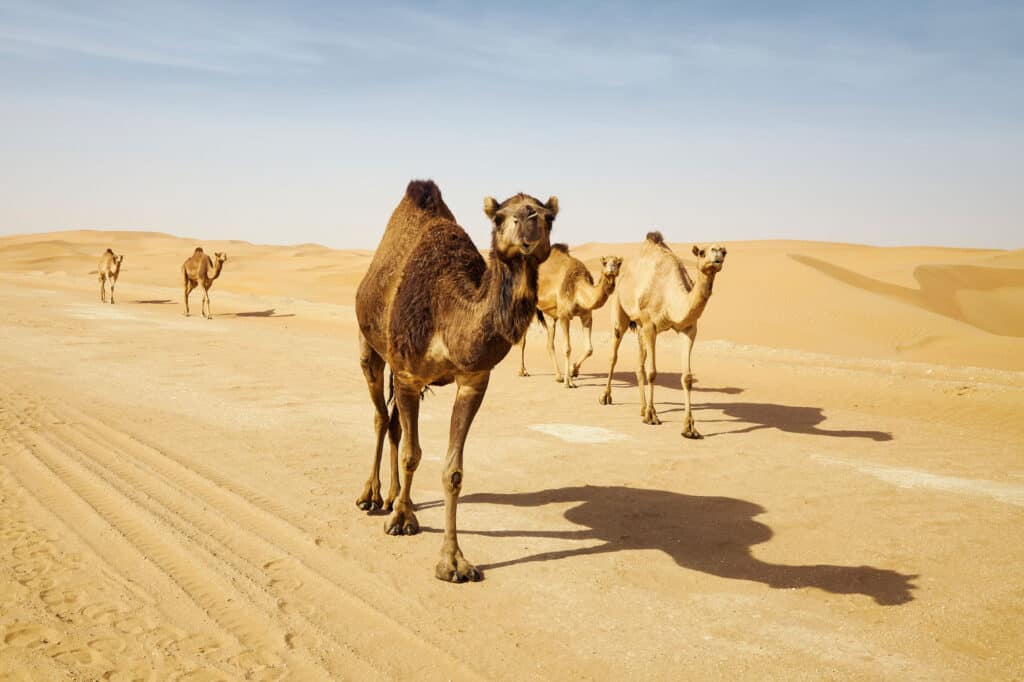
Camels
are one of the first animals people think of when thinking of the desert.
©iStock.com/Chalabala
| Height | Length | Weight |
|---|---|---|
| 5.9 to 6.6 ft. | 10 to 11.5 ft. | 990 to 1,100 lbs |
Camels are one of the first animals people think of when thinking of the desert, and they are also one of the largest animals that live in dry habitats. There are two camel species, the Bactrian camel (Camelus bactrianus), and the dromedary camel (Camelus dromedarius). The most common camel is the dromedary camel, which makes up for around 90% of the camel population on earth. Bactrian camels, while rare, are heavier, and inhibit the Gobi Desert.
Dromedary camels are common throughout North Africa, and the Middle East. Camels have been domesticated since they are adapted to live in a harsh desert environment, and can travel long distances without water. Most think the humps of a camel are used to store water, but it is actually for fats. Storing fats helps them survive when food is scarce which is common in deserts. Camels store water in their blood and can go without a drink for 15 days. When water is available camels can drink up to 20 gallons at a time.
Desert Rhino
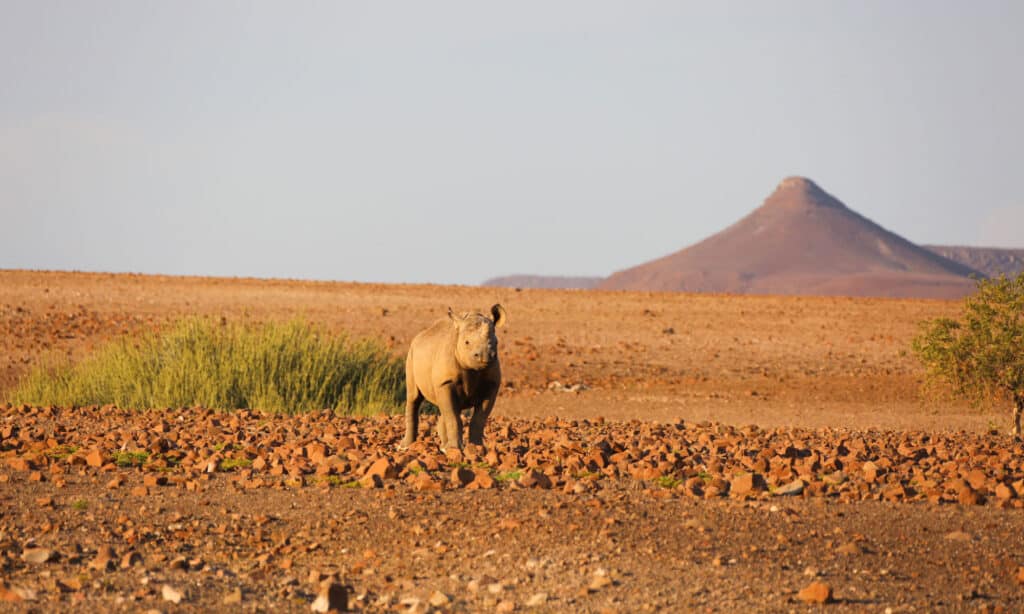
Desert rhinos are a type of
black rhino
that are adapted to live in a desert.
©Shantelle Borges/Shutterstock.com
| Height | Length | Weight |
|---|---|---|
| 4.3 to 6.6 ft. | 9.2 to 12 ft. | 1,800 to 3,100 lbs |
Desert rhinos are a type of black rhino that are adapted to live in a desert. While desert rhinos are just as large, they have adapted traits and slightly different lifestyles to help them live in a desert habitat. Desert rhinos are able to go 2 to 3 days without water and are typically nocturnal to avoid the heat of the sun. They have a gray, and dark color, that reflects light. Desert rhinos will also find mudholes to wallow in to protect their skin.
Desert rhinos are extremely nomadic and are capable of surviving in various other habitats. The population decline of rhinos across the world is due to the hunting, and poaching of this species’ horn. Black rhinos, along with the Javan and Sumatran rhinos are considered critically endangered. Desert rhinos are extremely large, and they spend most of their time looking for food, and water.
Giraffe
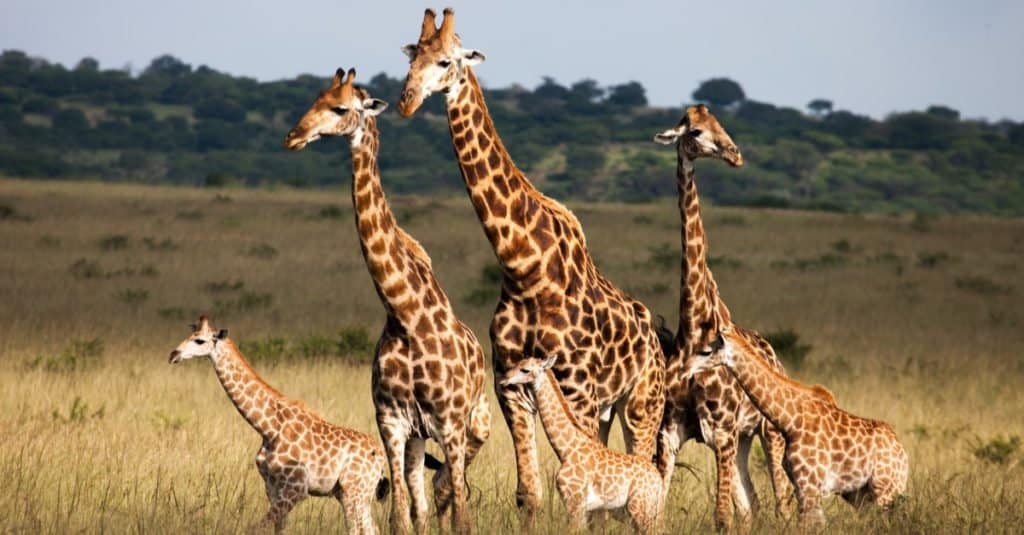
Giraffes are native to Africa, and deserts are just one of the habitats they live in.
©Craig Fraser/Shutterstock.com
| Height | Length | Weight |
|---|---|---|
| 14 to 19 ft. | 7.5 to 8.5 ft. | 2,600 to 4,200 lbs |
Giraffes are the tallest land animal currently on earth, and are also one of the heaviest animals that live in deserts. Giraffes are native to Africa, and deserts are just one of the habitats they live in. Open woodlands, grasslands, and savannas are some of the other habitats that giraffes live in, with their range being spread across the sub-Sahara of Africa.
There are four species of giraffes that exist which are the Masai giraffe, the Northern giraffe, the Reticulated giraffe, and the Southern Giraffe. The Masai giraffe is the largest species of them all, and lives in semi-desert regions.
The food that giraffes eat helps them survive in deserts since they get water from the plant life they feed on. Vachellia and Sedalia leaves are what they eat the most. They have extremely long tongues and necks to reach the highest points of trees. Giraffes are the tallest mammal in the world, and even when born are about 6 feet tall.
African Bush Elephant
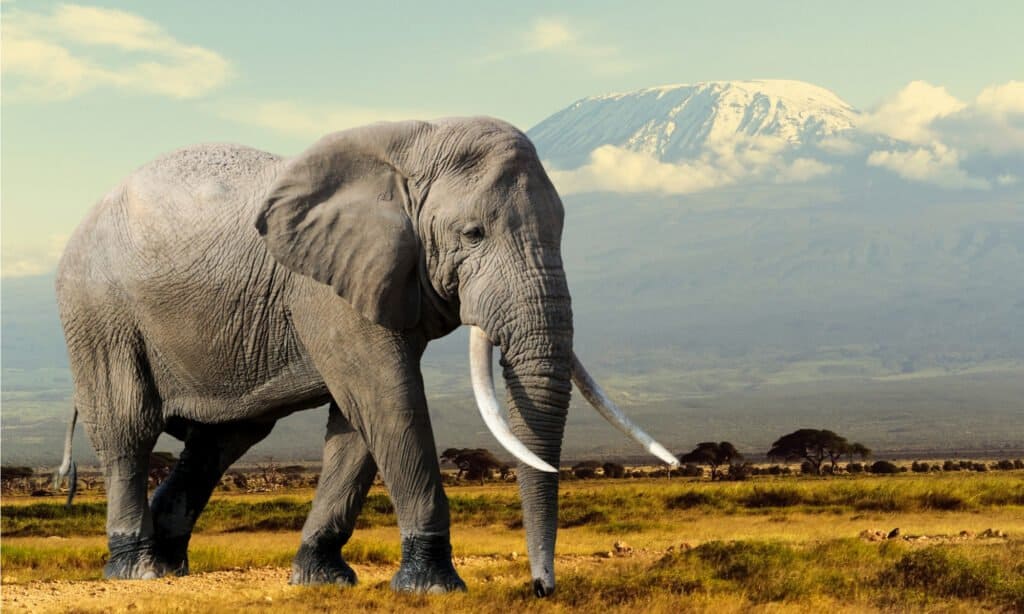
Out of all the desert animals that live in the world, the
African bush elephant
(Loxodonta africana) is the largest animal that lives in a desert.
©Volodymyr Burdiak/Shutterstock.com
| Height | Length | Weight |
|---|---|---|
| 8.2 to 13 ft. | 18 to 24 ft. | 6,000 to 13,000 lbs |
Out of all the desert animals that live in the world, the African bush elephant (Loxodonta africana) is the largest animal that lives in a desert. African bush elephants are also the largest land animal. When born this species is already extremely large, with an average weight of around 260 lbs, and a height of around 3 feet. African bush elephants also have the longest gestation period of any animal, with females staying pregnant for 22 months long.
The floppy ears, long trunk, and tusks are common traits of the African bush elephant. Their tusks grow to be around 5 to 8 feet and weigh around 50 to 100 lbs. Males grow much larger than females, but both sexes grow their entire lives.
Plants like grass, leaves, and even fruits. African bush elephants are herbivores, and eat up to 600 lbs. of food in a day. African bush elephant males are larger than females and have an average weight of around 13,000 lbs. The largest ever recorded weighed 24,000 lbs, and stood 13 feet tall.
Up Next:
- 8 Birds That Live in Deserts
- The 9 Deadliest and Most Dangerous Deserts on Earth
- The 15 Largest Deserts in the World
The photo featured at the top of this post is © Anton Petrus/Shutterstock.com
Sources
- Desert Animals , Available here: https://www.desertusa.com/animals.html
- Desert Animals List , Available here: https://www.animalspot.net/desert-animals
- Adaptations in Desert Animals , Available here: https://animalsake.com/adaptations-in-desert-animals
FAQs (Frequently Asked Questions)
What is a desert?
Deserts are extremely dry and are one of the most extreme habitats on the planet. It is estimated around 33% of the earth’s land surface is desert, and these areas get no more than 10 inches of precipitation a year. While most think deserts are barren wastelands, you can find a variety of wildlife and plants adapted to live in these dry regions.
What helps an animal adapt to desert conditions?
Some of the adaptations these animals have made include being able to go without water for long stretches of time, choosing plant life that will keep them hydrated and their sheer size.
Thank you for reading! Have some feedback for us? Contact the AZ Animals editorial team.




